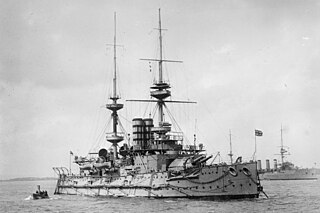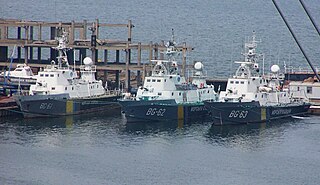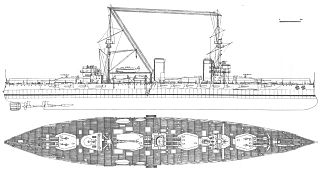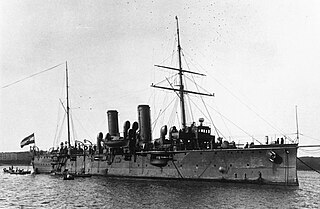
In naval terminology, a destroyer is a fast, maneuverable, long-endurance warship intended to escort larger vessels in a fleet, convoy, or carrier battle group and defend them against a wide range of general threats. They were originally conceived in 1885 by Fernando Villaamil for the Spanish Navy as a defense against torpedo boats, and by the time of the Russo-Japanese War in 1904, these "torpedo boat destroyers" (TBDs) were "large, swift, and powerfully armed torpedo boats designed to destroy other torpedo boats". Although the term "destroyer" had been used interchangeably with "TBD" and "torpedo boat destroyer" by navies since 1892, the term "torpedo boat destroyer" had been generally shortened to simply "destroyer" by nearly all navies by the First World War.

The Majestic class of nine pre-dreadnought battleships were built for the Royal Navy in the mid-1890s under the Spencer Programme, named after the First Lord of the Admiralty, John Poyntz Spencer. With nine units commissioned, they were the most numerous class of battleships. The nine ships, HMS Majestic, Caesar, Hannibal, Illustrious, Jupiter, Magnificent, Mars, Prince George, and Victorious, were built between 1894 and 1898 as part of a programme to strengthen the Royal Navy versus its two traditional rivals, France and Russia. This continued the naval re-armament initiatives begun by the Naval Defence Act 1889.

The Courageous class consisted of three battlecruisers known as "large light cruisers" built for the Royal Navy during the First World War. The class was nominally designed to support the Baltic Project, a plan by Admiral of the Fleet Lord Fisher that was intended to land troops on the German Baltic Coast. Ships of this class were fast but very lightly armoured, with only a few heavy guns. They were given a shallow draught, in part to allow them to operate in the shallow waters of the Baltic but also reflecting experience gained earlier in the war. To maximize their speed, the Courageous-class battlecruisers were the first capital ships of the Royal Navy to use geared steam turbines and small-tube boilers.

The Mackensen class was the last class of battlecruisers to be built by Germany in World War I. The design initially called for seven ships, but three of them were redesigned as the Ersatz Yorck class. Of the four ships of the Mackensen class, Mackensen, Graf Spee, and Prinz Eitel Friedrich were launched, and Fürst Bismarck was not—but none were completed, after wartime shipbuilding priorities were redirected towards U-boats—and the ships were broken up in the early 1920s. The lead ship of the class was named for August von Mackensen, a prominent military commander during the war. In response to the Mackensen-class ships, the British Royal Navy laid down the Admiral-class battlecruisers, all but one of which would eventually be cancelled; the sole survivor, HMS Hood, was completed after the end of the war.

The United States' S-class submarines, often simply called S-boats, were the first class of submarines with a significant number built to United States Navy designs. They made up the bulk of the USN submarine service in the interwar years and could be found in every theater of operations. While not considered "Fleet Submarines" in the traditional sense of that term, they were the first submarines in the USN designed for open ocean, blue water operations. All previous submarines had been intended for harbor or coastal defense. These boats were intended to have greater speed and range than previous classes, with improved habitability and greater armament.
The Admiral-class battlecruisers were to have been a class of four British Royal Navy battlecruisers built near the end of World War I. Their design began as an improved version of the Queen Elizabeth-class battleships, but it was recast as a battlecruiser after Admiral John Jellicoe, commander of the Grand Fleet, pointed out that there was no real need for more battleships, but that a number of German battlecruisers had been laid down that were superior to the bulk of the Grand Fleet's battlecruisers and the design was revised to counter these. The class was to have consisted of HMS Hood, Anson, Howe, and Rodney — all names of famous admirals — but the other three ships were suspended as the material and labour required to complete them was needed for higher-priority merchantmen and escort vessels. Their designs were updated to incorporate the lessons from the Battle of Jutland, but the Admiralty eventually decided that it was better to begin again with a clean-slate design so they were cancelled in 1919. No more battlecruisers would be built due to the arms limitations agreements of the interbellum.

The Sovetsky Soyuz-class battleships, also known as "Stalin's Republics", were a class of battleships begun by the Soviet Union in the late 1930s but never brought into service. They were designed in response to the Bismarck-class battleships being built by Germany. Only four hulls of the fifteen originally planned had been laid down by 1940, when the decision was made to cut the program to only three ships to divert resources to an expanded army rearmament program.

The O class was a planned class of three battlecruisers for the Kriegsmarine before World War II. Prompted by a perceived lack in ship numbers when compared with the British Royal Navy, the O class' design was born with the suggestion of modifying the P-class cruiser design with 380 mm (15 in) guns instead of 283 mm (11.1 in).
During World War II, Nazi Germany's Kriegsmarine considered various submarine designs for specialized operations or improving U-boat performance. Many of these designs did not come to fruition for various reasons. Some were abandoned due to practical considerations. Others towards the end had to be abandoned as the yards were overrun by allied forces.

The Hatsuharu-class destroyers were a class of Imperial Japanese Navy destroyers in the service before and during World War II. The final two vessels in the class, completed after modifications to the design, are sometimes considered a separate "Ariake class".

The République class consisted of a pair of pre-dreadnought battleships—République, the lead ship, and Patrie—built for the French Navy in the early 1900s. They were ordered as part of a naval expansion program directed at countering German warship construction authorized by the German Naval Law of 1898. The French program called for six new battleships; the last four became the very similar Liberté class. République and Patrie, designed by Louis-Émile Bertin, were a significant improvement over previous French battleships. They carried a similar offensive armament of four 305 mm (12 in) guns and eighteen 164 mm (6.5 in) guns, though most of the 164 mm guns were now mounted in more flexible gun turrets rather than in casemates. They also had a much more effective armor protection arrangement that remedied the tendency of earlier battleships to lose stability from relatively minor damage.

The Karlsruhe class of light cruisers was a pair of two ships built for the German Imperial Navy before the start of World War I. The ships—SMS Karlsruhe and Rostock—were very similar to the previous Magdeburg-class cruisers, mounting the same armament and similar armor protection, though they were larger and faster than the earlier ships. Both vessels were laid down in 1911, and launched one day apart, on 11 and 12 November 1912. Karlsruhe joined the fleet in January 1914, but fitting out work lasted slightly longer on her sister; Rostock was commissioned the following month.

SMS Kaiserin und Königin Maria Theresia was an armored cruiser used by the imperial Austro-Hungarian Navy from 1895 to 1917; she was the first ship of that type built by the Austro-Hungarian Navy. The ship was a unique design, built by the Stabilimento Tecnico Triestino shipyard in Trieste; she was laid down in July 1891, launched in April 1893, and completed in November 1894. Armed with a main battery of two 24-centimeter (9.4 in) guns and eight 15 cm (5.9 in) guns, the ship provided the basis for two subsequent armored cruiser designs for the Austro-Hungarian Navy.

L 20e α was a design for a class of battleships to be built in 1918 for the German Kaiserliche Marine during World War I. Design work on the class of battleship to succeed the Bayern-class battleships began in 1914, but the outbreak of World War I in July 1914 led to these plans being shelved. Work resumed in early 1916 and lessons from the Battle of Jutland, fought later that year, were incorporated into the design. Reinhard Scheer, the commander of the fleet, wanted larger main guns and a higher top speed than earlier vessels, to combat the latest ships in the British Royal Navy. A variety of proposals were submitted, with armament ranging from the same eight 38 cm (15 in) guns of the Bayern class to eight 42 cm (16.5 in) guns.

The Stenka class is the NATO reporting name for a class of patrol boats built for the Soviet Navy and Soviet Allies. The Soviet designation was Project 205P Tarantul. The boats are an anti-submarine (ASW) patrol boat version of the Osa-class missile boat.
The Osvetnik class consisted of two submarines built for the Kingdom of Serbs, Croats and Slovenes – Yugoslavia from 1929 on – by Ateliers et Chantiers de la Loire in Nantes, France. Launched in 1928 and 1929, the boats were named Osvetnik (Avenger) and Smeli (Daring). They were built to a partial double hull Simonot design similar to the French Circé-class submarines. Also known as the Smeli class, they were the second class of submarines to serve in the Royal Yugoslav Navy (KM), and after extensive sea trials and testing they sailed from France to the Adriatic coast of Yugoslavia, arriving in December 1929, where they joined the two larger British-made Hrabri-class submarines to make up the pre-war Yugoslav submarine flotilla. The Osvetnik-class were armed with six 550 mm (22 in) torpedo tubes, one 100 mm (3.9 in) gun, and one 40 mm (1.6 in) anti-aircraft gun, and could dive to 80 metres (260 ft).

The Russian battleship Sinop was a battleship built for the Imperial Russian Navy, being the third ship of the Ekaterina II class. She was named after the Russian victory at the Battle of Sinop in 1853. The ship participated in the pursuit of the mutinous battleship Potemkin in June 1905 and towed her back to Sevastopol from Constanța, Romania, where Potemkin had sought asylum. Several proposals were made for Sinop's reconstruction with modern guns and better quality armor during the 1900s, but both were cancelled. She was converted to a gunnery training ship in 1910 before she became a guardship at Sevastopol and had her 12-inch (305 mm) guns removed in exchange for four single 203 mm (8.0 in)/50 guns in turrets. Sinop was refitted in 1916 with torpedo bulges to act as "mine-bumpers" for a proposed operation in the heavily mined Bosphorus. Both the Bolsheviks and the Whites captured her during the Russian Civil War after her engines were destroyed by the British in 1919. She was scrapped by the Soviets beginning in 1922.

Imperator Nikolai I was a Russian dreadnought built during World War I for service in the Black Sea. She was designed to counter multiple prospective Ottoman dreadnoughts which had been placed under order by the Ottoman government, since this raised the possibility that the Russian dreadnoughts being built for the Black Sea Fleet could be outclassed. The ship used the same main armament as the preceding Imperatritsa Mariya class, but was larger and more heavily armored. Imperator Nikolai I was launched in 1916, but construction was suspended on 24 October 1917. The Soviets considered completing her in 1923, but later rejected the idea. She was towed to Sevastopol in 1927 and scrapped.

Francesco Morosini was an ironclad battleship built in the 1880s and 1890s for the Italian Regia Marina. The ship, named for Francesco Morosini, the 17th-century Doge of Venice, was the second of three ships in the Ruggiero di Lauria class, along with Ruggiero di Lauria and Andrea Doria. She was armed with a main battery of four 356 mm (14 in) guns, was protected with 451 mm (17.75 in) thick belt armor, and was capable of a top speed of 17 knots.

The Zenta class was a group of three protected cruisers built for the Austro-Hungarian Navy in the 1890s.



















